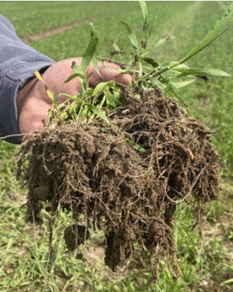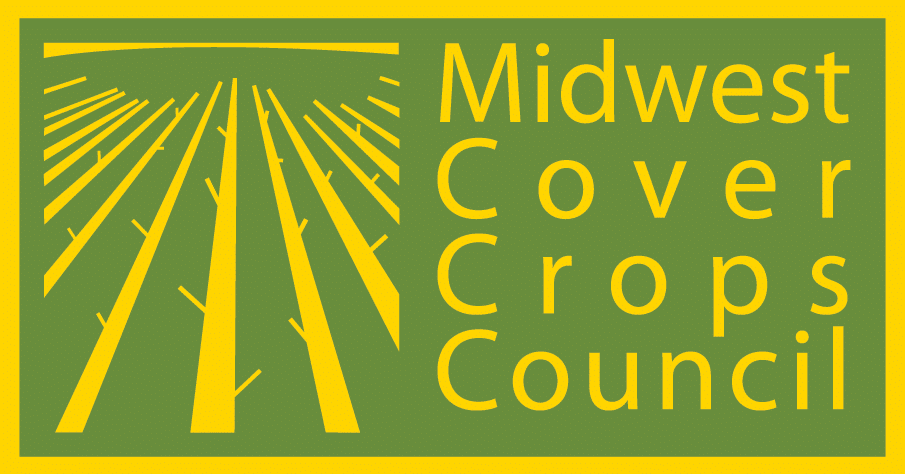Midwest Cover Crops Council (MCCC-132)
Michigan State University Extension (CC-08)
This publication is intended to provide a starting point for farmers who are new to growing cover crops. With experience, farmers may fine-tune the use of cover crops for their systems.
Introduction
This recipe provides an approach to growing a winter cereal grain cover crop after dry bean harvest in a dry bean–corn rotation as a way to introduce a cover crop. (Note: Cereal rye [Secale cereale] and annual ryegrass [Lolium multiflorum] are two different species and should not be used interchangeably.)
Planning and Preparation
- Planning—Educate yourself. Start small. Be timely. Make a rotation plan that works for your finances and soil. Keep notes on the results to guide you in future decisions.
- Dry bean variety and planting—If possible, plant the dry bean crop early and use an early maturity cultivar.
- Residual dry bean herbicides—Cereal grains can be seeded and successfully established in the fall following most spring-applied herbicides used in dry bean. See the Weed Control Guide for Field Crops (MSUE Bulletin E0434) in the Resources section, and consult the section on dry bean and herbicide crop rotation restrictions (i.e., Table 12) for more details.
- Seed purchase—Order seed early. Named varieties perform more predictably, typically providing better growth than variety not stated (VNS) or bin run seed, but are more expensive. Even VNS seed should be purchased from a reputable dealer, cleaned, tested for germination, and have a seed tag.
Fall Work
- Dry bean harvest—Harvest fields where a cover crop is to be planted as early as possible.
- Tillage or no tillage—To allow for adequate cover crop growth, it is best if no full-width tillage is planned after planting the winter cereal or before termination. If tillage is used, it is better to wait until spring to maintain soil cover to prevent erosion.
- Timing of planting—Ideally, plant a cereal grain as soon after harvest as possible and no later than one week after the 50% frost date. On average, plant before these dates: Upper Peninsula, Oct. 11; northern Lower Peninsula, Oct. 15; central Lower Peninsula, Oct. 25; and southern Lower Peninsula, Oct. 28. Use the Cover Crop Selector Tool (in Resources section) for more precise seeding dates for your county. Proximity to the Great Lakes and latitude influence these dates.
- Planting method—Drill to 0.75–1.50 inches deep or broadcast with shallow incorporation. Good seed-soil contact will ensure a more reliable stand. Check that seed is being planted as expected. If possible, plant when soil moisture is available or just prior to a rain event. See pages 7–9 in the Michigan Technical Note: Cover Crop Chart in the Resources section.
- Seeding rate—Drilled: 50–80 lbs./acre. Broadcast with shallow incorporation: 60–100 lbs./acre. These rates are based on high-quality seed with 85–98% germination.
- Fertility or liming—If applying P, K, lime, or manure, complete the application and incorporation prior to seeding or apply to growing cereal cover crop before the ground freezes. Low-disturbance injectors minimize damage to the cover crop. Surface application of liquid manure on top of the cereal cover crop is not recommended as nitrogen can be lost into the air and run off with rain and melting snow. Surface-broadcast of dry manure should be done prior to seeding, but 4 tons/acre or less can be applied to a growing cereal cover crop with minimal damage if evenly distributed.
Spring Work
- Scouting—In the spring, scout your cover crop to determine growth and coverage. If rainfall is below normal, monitor soil moisture in case earlier termination is needed.
- Termination timing—Cereal grains usually grow rapidly in the spring, so have a termination plan ready. Terminate when plants are 6–12 inches tall and actively growing or about two weeks before planting—whichever comes first. See Cover Crop Termination (MSUE publication CC-01) in the Resources section for more information.
- Termination by herbicide—Cereal grain can be terminated with full-rate glyphosate (minimum of 1.13 lb. acid equivalent [ae]/acre) plus ammonium sulfate (8.5–17 lbs./100 gal.) after dormancy breaks. To maximize the effectiveness of the glyphosate and minimize time for complete control, apply when the cover crop is actively growing and temperatures favor growth (air temperatures consistently ≥50°F). Winter cereals past the boot stage or those sprayed during cooler weather can be more difficult to kill or will die more slowly. Monitor control after application as sometimes a second application is necessary. Be aware that when conditions are cool and cloudy, atrazine and saflufenacil tank mixtures with glyphosate may delay or antagonize glyphosate activity for wheat termination. See MSUE Bulletin E0434 or MSUE publication CC-01 (in Resources section) for more herbicide information.
- Termination by tillage—Tillage can be a reliable termination method. However, multiple passes may be required, depending on the cover crop stand. (See MSUE publication CC-01 in Resources section.) Note that disturbance of the soil may reduce the benefits of the cover crop.
- Termination modifications for adverse weather—Watch the weather and be ready to modify your plans. In a dry spring, the cereal grain can use moisture needed by the cash crop, so terminate sooner to capture rainfall for use by the following crop. In a wet spring, when using herbicides to terminate cereal grain, be ready to use any break in the weather and/or low axle weight sprayers.
- Starter fertilizer for corn after cereal grain cover crops—Cereal grains can tie up nitrogen, reducing its availability to corn. A 2×2 starter fertilizer (2 inches deep and 2 inches to one side of corn seed) application rate of 30–50 pounds of actual N per acre is recommended.
- Corn planting—It is usually best to no-till corn into dead/dry or standing cereal grain cover crops to reduce weed competition. Check planting depth and seed furrow closure shortly after beginning to plant into the cover crop residue and adjust as needed.
- Scouting—After planting, scout for pests, corn emergence, and population. Additionally, scout for weeds since substantial cereal grain residue can often delay emergence of annual weeds, which may then delay the application of post-emergence herbicides.

Resources
Cover Crop Selector Tool —available from the Midwest Cover Crops Council, www.midwestcovercrops.org
Weed Control Guide for Field Crops (Michigan State University Extension publication E0434)
Michigan Technical Note: Cover Crop Chart (Agronomy #64, March 2013)—available from the USDA–Natural Resources Conservation Service
Cover Crop Termination (Michigan State University Extension publication CC-01)
“Winter Wheat” in Managing Cover Crops Profitably (Sustainable Agriculture Network)
Authors
Christina Curell, Paul Gross, Monica Jean, and Philip Kaatz, Michigan State University Extension; and Vicki Morrone, Michigan State University (Note: This publication was adapted with consent from MCCC under a joint project to produce customized introductory guidance about cover crops for all member states/provinces.)
Reviewers and Contributors
Scott Bales, Erin Hill, and Dennis Pennington, Michigan State University; Eileen J. Kladivko, Purdue University; Anna L. Morrow, Midwest Cover Crops Council
The Midwest Cover Crops Council (www.midwestcovercrops.org) aims to facilitate widespread adoption of cover crops throughout the Midwest by providing educational/outreach resources and programs, conducting new research, and communicating about cover crops to the public.
Funding for this project was provided by McKnight Foundation.
November 2022
The U.S. Department of Agriculture (USDA) prohibits discrimination in all its programs and activities on the basis of race, color, national origin, age, disability, and where applicable, sex, marital status, familial status, parental status, religion, sexual orientation, genetic information, political beliefs, reprisal, or because all or a part of an individual’s income is derived from any public assistance program. (Not all prohibited bases apply to all programs.) Persons with disabilities who require alternative means for communication of program information (Braille, large print, audiotape, etc.) should contact USDA’s TARGET Center at (202) 720-2600 (voice and TDD). To file a complaint of discrimination write to USDA, Director, Office of Civil Rights, 1400 Independence Avenue, S.W., Washington, D.C. 20250-9410 or call (800) 795-3272 (voice) or (202) 720-6382 (TDD). USDA is an equal opportunity provider and employer. ©2022 by MCCC. All rights reserved.
